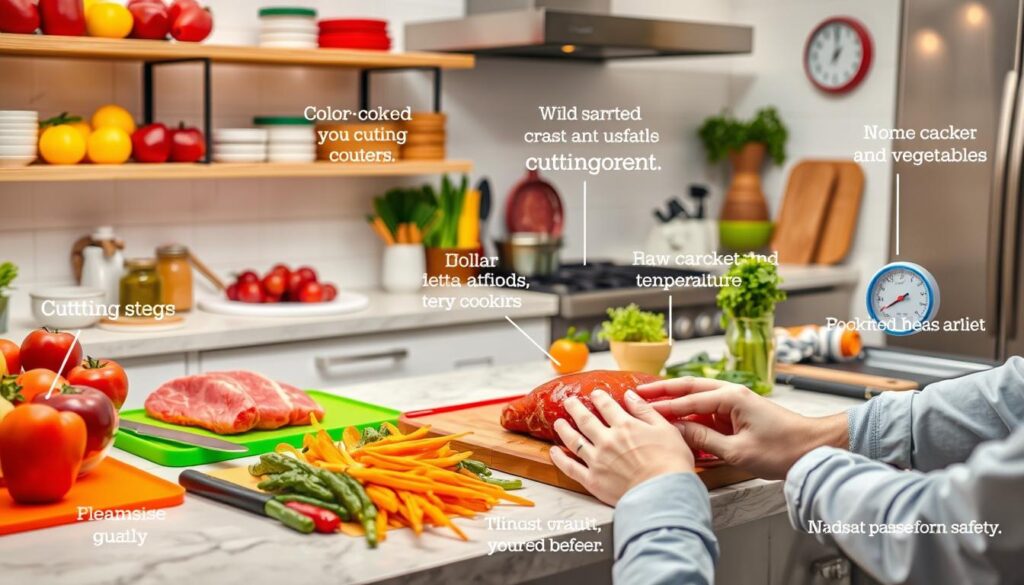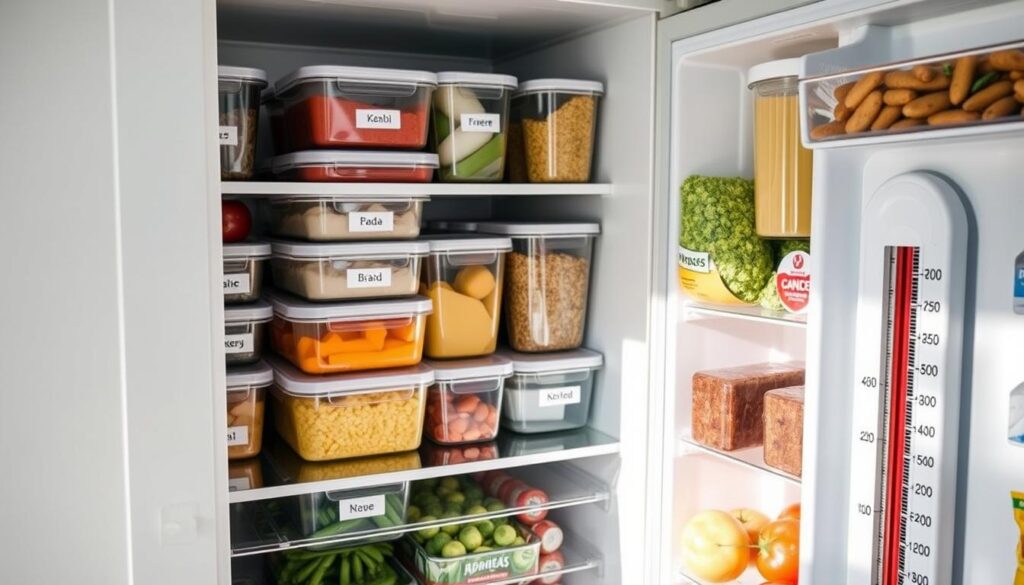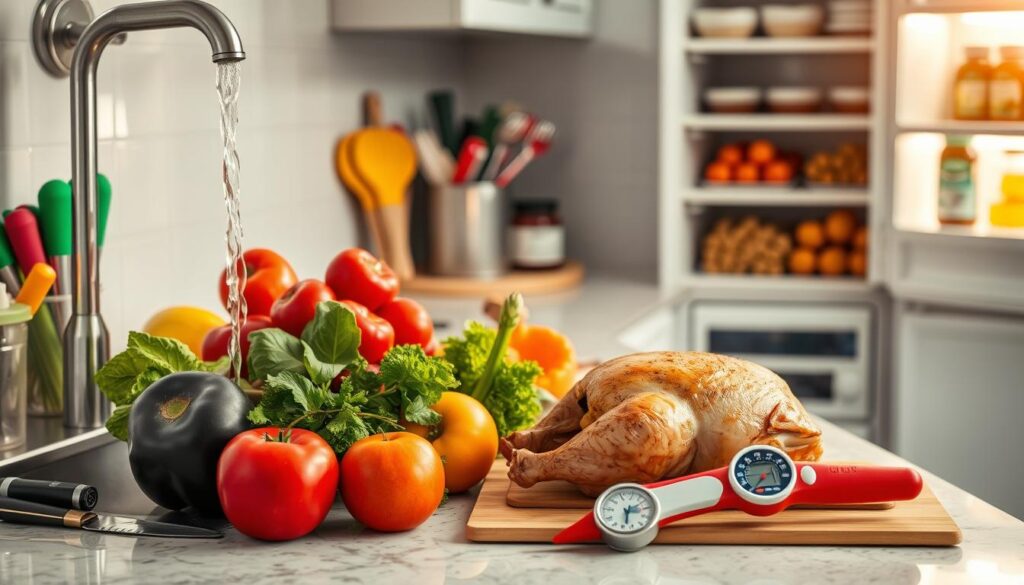Do you know the risks of mishandling food in your kitchen? Handling food the wrong way can affect your health. We’ll explore food safety tips to keep your family safe and your kitchen a joy to cook in.
Key Takeaways
- Understand common food safety misconceptions and learn the fundamental principles for keeping food safe
- Discover the importance of proper temperature control and effective kitchen hygiene practices
- Explore safe food preparation guidelines and methods to prevent cross-contamination
- Learn how to navigate grocery shopping and food transport with food safety in mind
- Utilize the Food Scan Genius app to simplify food safety and access crucial nutritional information
Understanding Food Safety Fundamentals
Food safety is crucial, and knowing the facts is key. Many myths can harm our health. Let’s clear up common misconceptions and learn the basics of food handling.
Common Food Safety Misconceptions
- Rinsing raw poultry under water can remove bacteria: This is a common myth. In reality, rinsing raw poultry can actually spread harmful bacteria around the kitchen, leading to potential food contamination.
- Leaving food out overnight is safe if it’s reheated: Bacteria can multiply quickly at room temperature, even if the food is reheated later. Proper food hygiene means discarding any perishable items that have been left out for more than two hours.
- Cutting boards don’t need to be cleaned after each use: Cross-contamination can occur if you use the same cutting board for both raw and cooked foods without proper food preparation hygiene.
Basic Food Safety Principles
Food safety is based on four key principles: clean, separate, cook, and chill. Following these principles can help prevent foodborne illnesses:
- Clean: Wash hands, surfaces, and utensils frequently to remove harmful bacteria.
- Separate: Keep raw and cooked foods apart to avoid cross-contamination.
- Cook: Ensure that foods are cooked to the proper internal temperature to kill any lingering pathogens.
- Chill: Refrigerate or freeze perishable items promptly to slow the growth of bacteria.
The Impact of Poor Food Handling
Ignoring basic food safety principles can have serious consequences. Foodborne illnesses caused by improper food preparation or storage can lead to unpleasant symptoms, hospitalization, and in severe cases, even death. By understanding and applying these fundamental food safety practices, we can protect ourselves and our loved ones from the risks of food contamination.

“Food safety is not just a personal issue – it’s a public health concern that affects us all. Practicing good food hygiene habits can make a world of difference.
Proper Temperature Control for Safe Food Storage
Keeping the right temperature is key for food safety at home. Whether you’re storing perishables in the fridge or freezing food, knowing the ideal temperatures is crucial. It helps keep your food fresh and stops harmful bacteria from growing.
The Food and Drug Administration (FDA) says to keep your fridge at 40°F (4°C) or lower. Your freezer should be at 0°F (-18°C) or colder. This range slows down harmful microorganisms that can make you sick. Here are some tips for keeping your kitchen temperatures right.
Refrigerator Storage
- Don’t overload your fridge. It can mess with the airflow and cool unevenly.
- Put raw meats, poultry, and seafood on the bottom shelf. This stops them from getting mixed with other foods.
- Keep your fridge organized. This lets air move freely and keeps the temperature even.
- Use a fridge thermometer to check the temperature often. Make sure it’s in the safe range.
Freezer Storage
- Freeze foods at the coldest setting, which is usually 0°F (-18°C) or colder.
- Wrap or package foods tightly. This prevents freezer burn and keeps them fresh.
- Label and date frozen items. It helps you know how long they’ve been there.
- Try not to open the freezer door too often. It can change the temperature.
| Food Item | Refrigerator Temperature | Freezer Temperature |
|---|---|---|
| Raw Meat and Poultry | 40°F (4°C) or below | 0°F (-18°C) or below |
| Cooked Leftovers | 40°F (4°C) or below | 0°F (-18°C) or below |
| Dairy Products | 40°F (4°C) or below | 0°F (-18°C) or below |
| Fruits and Vegetables | 40°F (4°C) or below | 0°F (-18°C) or below |
By keeping your fridge and freezer at the right temperature, you ensure food safety and quality. Always check your appliance temperatures and adjust as needed. This keeps your food fresh and safe to eat.

Essential Kitchen Hygiene Practices
Keeping your kitchen clean is key for food safety. It helps stop the spread of foodborne illnesses. Here are three important practices for every home cook.
Sanitizing Kitchen Surfaces
It’s vital to sanitize kitchen surfaces like countertops and sinks. Use a bleach solution or a commercial sanitizer to kill bacteria like Salmonella and E. coli. Clean these areas after each use and deep clean weekly for the best food hygiene.
Hand Washing Techniques
Proper hand washing stops the spread of foodborne pathogens. Wash your hands with soap and warm water for 20 seconds. Make sure to clean between your fingers, under your nails, and up to your wrists. Dry your hands with a clean towel or paper towel to avoid recontamination.
Kitchen Tool Maintenance
It’s important to keep kitchen tools clean and in good shape. Wash and sanitize knives, cutting boards, and utensils regularly. Replace any worn-out or damaged tools to prevent bacteria buildup.
By following these simple hygiene practices, you’ll make your kitchen safer for everyone.
Safe Food Preparation Guidelines
Proper food preparation is key to avoiding foodborne illnesses. To make sure your meals are tasty and safe, we’ll look at important guidelines. These include safe cooking temperatures and how to handle raw ingredients.
Achieving Safe Cooking Temperatures
Cooking food to the right temperature is vital for food safety. Here are the minimum internal temperatures for various foods:
- Poultry: 165°F (74°C)
- Ground meats: 160°F (71°C)
- Steaks and chops: 145°F (63°C)
- Fish: 145°F (63°C)
- Eggs: 160°F (71°C)
Using a reliable food thermometer is the best way to check if your food is cooked safely.
Proper Thawing Techniques
Thawing frozen foods correctly is also crucial for food preparation. The best methods are:
- Refrigerator thawing: This slow and safe method allows food to thaw gradually without risk of bacterial growth.
- Cold water thawing: Submerge the food in cold water, changing the water every 30 minutes to keep it cold.
- Microwave thawing: Use the defrost setting on your microwave, but be sure to cook the food immediately after.
Avoid thawing food at room temperature, as this can promote the growth of harmful bacteria.
Handling Raw Ingredients Safely
When working with raw meats, poultry, or seafood, always remember to:
- Use separate cutting boards and utensils for raw and cooked foods
- Wash your hands thoroughly before and after handling raw ingredients
- Store raw foods below cooked or ready-to-eat foods in the refrigerator
By following these food preparation guidelines, you can ensure your meals are not only delicious but also safe for you and your loved ones to enjoy.
Cross-Contamination Prevention Methods
Keeping food safe at home is key. Cross-contamination happens when bacteria from one food spread to another. This can cause foodborne illnesses. Let’s look at ways to keep your kitchen safe from these risks.
Separating Raw and Cooked Foods
Keeping raw and cooked foods separate is a big step. Store raw meats, poultry, and seafood on the bottom fridge shelf. This keeps them away from foods you eat right away. Use different cutting boards and utensils for raw and cooked foods. Clean and sanitize surfaces well after handling raw foods.
Using Different Cutting Boards
Having more than one cutting board helps a lot. Use one for raw proteins and another for fruits, veggies, and cooked foods. This stops bacteria from spreading to safe foods.
Safe Food Storage Organization
- Organize your fridge and pantry with care. Raw foods go on the bottom, and cooked foods on top.
- Use airtight containers or sealed bags to stop drips or leaks. This prevents cross-contamination.
- Check expiration dates and use older items first. This helps avoid spoilage and contamination.
Using these methods can make your food safer. A bit of planning and care in the kitchen can protect your family. It’s all about being mindful and organized.
Food Safety During Grocery Shopping and Transport
Food safety doesn’t end when you leave the store. The trip from the shelves to your kitchen is key. Here are some tips to keep your groceries safe during transport.
Selecting Safe Grocery Items
When shopping, follow these food safety tips:
- Choose fresh, undamaged produce and meats that are properly refrigerated or frozen.
- Avoid purchasing items with damaged or compromised packaging, as this could lead to contamination.
- Inspect expiration dates and opt for the freshest products available.
Maintaining Temperature Control
Temperature is crucial for food safety. Keep perishable items, like meats, dairy, and frozen foods, cold:
- Use a cooler bag or insulated container to transport cold and frozen items.
- Make the grocery store your last stop before heading home to minimize time spent with temperature-sensitive foods.
- Avoid leaving perishable items in a hot car, as this can rapidly increase the risk of bacterial growth.
Separating for Safety
To prevent cross-contamination, pack your groceries carefully:
- Keep raw meats, poultry, and seafood separate from ready-to-eat foods.
- Use separate bags or containers for these items to avoid juices or liquids from leaking onto other products.
- If possible, place raw items at the bottom of your cart or bag to prevent dripping onto other foods.
By following these simple steps, you can keep your groceries safe and fresh. Food safety is a journey, and every step counts.
“Proper food handling and storage are crucial to prevent foodborne illnesses. Always be mindful of temperature, cross-contamination, and expiration dates when transporting your groceries.”
Using Food Scan Genius App for Better Food Safety
We’re excited to introduce you to the Food Scan Genius app. This app makes food safety easy at home. It helps you make smart choices about what you eat.
Barcode Scanning Features
The app’s barcode scanning is amazing. Just scan a product’s barcode with your phone. The app shows you all about the item, like ingredients and safety info.
Allergen Detection Benefits
If you have food allergies, this app is a lifesaver. It checks ingredients against a big list of allergens. You’ll know right away if a product is safe for you.
Nutritional Information Access
The app also shows nutritional info. You can see calories, nutrients, and labels like “organic.” This helps you choose healthier foods.
The Food Scan Genius app is great for anyone who cares about food safety. It scans barcodes, finds allergens, and shows nutritional info. It makes food safety easy and accessible.
| Feature | Benefit |
|---|---|
| Barcode Scanning | Instantly access detailed product information, including ingredients and potential allergens. |
| Allergen Detection | Identify and avoid food products that contain specific allergens, ensuring your safety. |
| Nutritional Information | Make informed decisions about the nutritional content of the foods you purchase and consume. |
The Food Scan Genius app has been a game-changer for my family. It’s given us the confidence to navigate the grocery store shelves and make informed choices about the food we bring into our home.
Understanding Food Labels and Expiration Dates
Food labels and expiration dates can seem overwhelming. But don’t worry, we’re here to help. We’ll guide you through the basics so you can make safe and informed choices. Let’s get started and learn what you need to know.
Deciphering Food Labels
Food labels are full of useful information. We’ll show you how to read them. You’ll learn about nutrition facts and ingredient lists. Knowing terms like “best by,” “use by,” and “sell by” helps you eat fresher and safer food.
Expiration Date Demystified
Expiration dates might confuse you, but they’re important. We’ll explain the differences between “best by,” “use by,” and “sell by” dates. This way, you can avoid food waste and keep your food safety in check. Remember, how you store and handle food also affects its shelf life.
Staying Informed, Staying Safe
Knowing about food labeling and expiration dates is key. It helps you make better choices, reduce waste, and keep your family healthy. Use this knowledge to make the most of your grocery trips.
Conclusion
As we wrap up our guide to food safety at home, let’s review what we’ve learned. Food safety is more than just personal health. It’s a shared duty to make our food environment healthier and safer for everyone.
Learning the basics of food safety helps us avoid foodborne illnesses. It’s important to know how to prevent cross-contamination and keep our kitchens clean. Paying attention to how we shop and store food also plays a big role.
Using tools like the Food Scan Genius app helps us make better choices. Knowing about food labels and expiration dates is key to staying safe. Let’s keep these practices in mind every day. This way, we can help create a safer food world for everyone.
FAQ
What are the basic food safety principles?
Basic food safety includes keeping food at the right temperature. It also means staying clean, avoiding mixing foods, and following safe cooking steps.
How can I prevent foodborne illnesses?
To stop foodborne illnesses, handle and store food safely. Always wash your hands well. Make sure food is cooked right.
What is the proper way to wash my hands for food safety?
To wash hands right, start with clean, running water. Use soap and scrub for 20 seconds. Then, rinse and dry well.
How do I properly store refrigerated and frozen foods?
Keep refrigerated foods at 40°F or below. Frozen foods need to be at 0°F or below. Clean your fridge often and check temperatures. Use airtight containers for food.
What is the importance of using different cutting boards for raw and cooked foods?
Using different cutting boards stops bacteria from spreading. This helps prevent foodborne illnesses.
How can the Food Scan Genius app help with food safety?
The Food Scan Genius app lets you scan barcodes. It shows product info, like allergens and nutrition. This helps you choose safe food.
How can I interpret food labels and expiration dates?
Food labels tell you about ingredients and expiration dates. Knowing this helps you pick safe and quality food.





